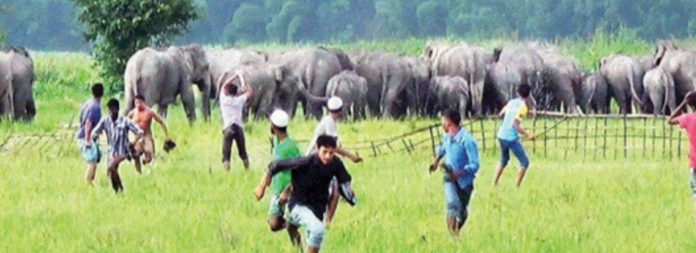One of the main root cause of human-elephant conflicts is appropriation of wildlife habitations by human. People who are suffering from human-elephant conflicts, follow lots of methods to expel elephants. But most of them are unsuccessful. Scientists, agriculturists, and researches do lots of experiments and researches to find a solution which can overcome this problem and is beneficial both human and elephants. Increasing the population of human is a reason to invade wildlife habitations. So wildlife has to sacrifice their habitations, and their lives for that. Planting palmyra trees on the roadsides, and the demarcations of the villages in a zig-zag way is the best method which can overcome this issue as both parties are benefited. Government involvement of the particular country is necessary to implement this method. And also, workshops or awareness programs should be organized to increase the awareness of the people. People get an additional income, shade. Elephants get food (fruits of palmyra trees), shade. Sri Lanka, Tanzania, Cameroon, Kenya are some of the countries which human-elephant conflicts can be observed.
Unsuccessful activities undertaken for conflict mitigation in the world.
- Elephant translocation
- Electric fencing
- Distributing firecrackers to farmers
- killing elephants
- Firing gunshots
- Beating drums
With the clearance of forests to settle colonies, food is less for elephants. So, they invade those villages/colonies. Elephant translocation is practiced to avoid human-wildlife conflicts. Elephants which destroys crop lands, home garden and houses, are caught, and they are translocated to other places. Then some elephants are died due to they can’t find food, and other reasons. Due to the activities of some people such as giving food for elephants, elephants come to roadsides and annoy people who travel on the road. Electric fences have been made to prevent it. But some elephants make their path to cross the electric fences by putting logs on to the electric fence. And also, sometimes other animals such as dog, deer, cows are injured or died due to electric fences. Therefore, electric fencing can’t be considered as a successful method to prevent human-elephant conflicts. Farmers use firecrackers to expel elephants. But it is a temporary solution. Firing gunshots and beating drums are practiced by Asian and African farmers to avoid/expel elephants. Responsible persons should choose or create a method which is beneficial for both parties (elephants and human). Most of the countries don’t recommend killing elephants due to elephant has a cultural influence in some countries such as Sri Lanka, Thailand. According to the survey, most of the people has not much knowledge about the effective methods which can overcome human-wildlife conflicts. Even though they are aware of those methods, they don’t practice them due to high cost, availability of resources and difficulty in maintaining. Therefore, they follow unsuccessful activities continuously. The involvement of government is essential to mitigate human-wildlife conflicts due to those reasons. Some people make trenches and manmade salt ponds (in the jungle) to mitigate human-elephant conflicts.
Methodology
Methods that can be minimized human-elephant conflicts.
- Planting Hana/ hemp on the demarcation of cultivated lands.
- Planting palmyra trees on the roadsides in the areas which human-elephant conflicts are frequently reported.
- Planting lime plants on the demarcations of cultivated lands.
- Planting bougainvillea.
- Beekeeping.
Data collection methods.
- Preparing surveys.
- Observations.
- Getting information from department of wildlife conservation.
- Getting information from the villagers who are suffering from human-elephant conflicts.
- Internet
Conservation measures that can mitigate human-elephant conflicts.
- Establishing elephant corridors
- Increasing the size or extent of protected areas.
- Translocating elephants.
- Electric fencing.
- Ex-situ conservation.
- Introducing National policies for elephant conservation.
- Integrating elephant conservation with economic development.
Mitigation strategies:
- Short term strategies (3 years and above)- translocating elephants to another protected area. Reducing deforestation. Increasing awareness of people about human-elephant conflicts and community development activities. Establishing permanent demarcations for protected areas.
- Mid-term strategies (1-3 years)- Increasing awareness of people about human-elephant conflicts. Translocating small herds of elephants which destroy crops. Increasing the connection between people and department of wildlife conservation (officers of department of wildlife conservation).
- Long-term strategies (1-12 months)- removing attacking elephants to crops and villagers by providing the equipment and things such as alarms, firecrackers. (using repellent methods).
The information about different methods of mitigating human-elephant conflicts were accumulated by different data collection methods such as surveys, Department of wildlife conservation, the villagers in the affected areas. According to the information, people are using both successful and unsuccessful methods. Those methods were categorized separately as successful methods and unsuccessful methods with the support of department of wildlife conservation.
Discussion
Elephants’ behavior:
If people have a good awareness about elephant’s behavior, they can avoid human-elephant conflicts. Elephants are herbivorous, and consume grasses, barks, grains, fruits. They can spend around 16 hours per day to search food. They can walk more than 30 km for searching food. Furthermore, they can walk silently. Therefore, some accidents and deaths can’t be avoided. According to observations which were got from case studies, lots of people have been died due to silent walking behavior of elephants. Elephants are afraid of small rodents such as mice, bees. Elephants don’t like lemons due to its smell. Elephant can consume around 200 kg per day. Due to their food requirement is high, they can destroy an entire cultivation land. Elephant is a pachyderm. So, they can sniff the smell of citrus plants from a considerable distance. People can create methods to prevent human-elephant conflicts by observing the behavior of elephants. They like to eat the things such as bananas, coconut, rice plants, corn and manioc. Elephants are inactive in day-time. So, they destroy lands and crop at night. Elephants are intelligent. They follow successful methods to break the electric fences. Example: using big trees, and put them on the electric fence. Elephants try to avoid the plants such as palmyra, citrus plants such as orange and lime, neem, teak, tobacco.
Some deaths of elephants are recorded due to falling into agro wells and falling into constructed water canals. Elephants invade the colonies or villages due to scarcity of food in the remaining forests. Accidents, poisoning, gunshots, natural incidents, diseases are the causes of elephant deaths. Sea, cactus plants/ biological fences, repellent plants, dogs, rivers are natural barriers for elephants. Electric fences, barbed wire fence are some artificial barriers for elephants.
Consequences of Human elephant conflicts:
Consequences of human elephant conflicts are loss of elephants and human lives, delaying developmental activities, high financial cost, cultural loss, crop raiding by the elephants. Most of the people who are living in the areas which human-elephant conflicts are happened frequently, have a poor living standard. When elephants destroyed their crops, houses and other properties, they lost their income source. Example: shopkeepers on the roadsides, farmers. The lives of shopkeepers on the roadsides in those areas, depend on the functionality of electric fences.
Successful methods to mitigate human elephant conflicts:
Signboards which indicate the elephant crossing places, have been built on the roadsides in risky areas. Family of palmyra tree is Arecaceae. Leaves, seeds, fruits and root of palmyra tree are used for different purposes. Palmyra trees should be grown in zig-zag way with 5-8 feet gap. Fruits of palmyra trees are used to produce economically important products. Palmyra trees bear fruits 12 years after planting. Palmyra tree bear six to twelve bunches per year and one bunch has about 50 fruits. Palmyra trees provide an additional income to farmers, jiggery makers and toddy tappers. And also, elephants can consume palmyra fruits. Until palmyra plants are grown up, electric fences should be maintained to protect palmyra plants. Palmyra trees act as a live fence. This method is beneficial for both parties. The trunk of palmyra trees has spine like a distinct leaf scars. It provides shade, fruits, oxygen. Selling citrus plants such as lemon plants to villagers is a better solution due to research scientists have found that elephants don’t like fruits of citrus family such as orange, lime. Pachyderms feel the fragrance of citrus from a great distance with good senses of smell. Yield of citrus plants such as orange, lime can be used as an additional income. Due to elephants don’t like the smell of lemon, Crops and rice stored in homes can be protected by planting orange trees/ lime trees around home gardens. But department of wildlife conservation mentioned that this has not been proved in Sri Lanka. Planting Hana on the demarcation of cultivated lands, making live fence by palmyra trees are the effective methods to keep away elephants from home gardens.
Ranking the methods according to the responses of people, department of wildlife conservation and observations.
| Method | Rating |
| Planting palmyra trees on the roadsides in the areas which human-elephant conflicts are frequently reported. | 1 |
| Planting Hana/ hemp on the demarcation of cultivated lands. | 2 |
| Planting bougainvillea. | 3 |
| Planting lime plants on the demarcations of cultivated lands. | 4 |
Some approaches that can prevent the human elephant conflicts:
When aggressive elephants come to villages, they should be captured with the support of department of wildlife conservation, and they should be translocated in conservational areas. Domesticating elephants and introducing elephants to recreation centers can be also practiced. Elephant orphanages have been also set up.
Conclusion
According to the farmer’s responses, observations and Department of wildlife conservation in Sri Lanka, planting palmyra trees on the roadsides, planting hemp and bougainvillea is recommended to prevent human-elephant conflicts. But planting palmyra tree on the roadsides, and demarcations of the villages which human-elephant conflicts are frequently reported, is the best method to overcome human-elephant conflicts as both human and elephants are benefited.
References:
Find a sustainable solution to human-elephant conflicts.
Available at: https://www.presidentsoffice.gov.lk
Accessed on: 27th April 2021
Ex situ conservation of Biodiversity.
Available at: https://www.hindawi.com
Accessed on: 27th April 2021
(PDF) Human-Elephant Conflict: A review of current management strategies and future directions.
Available at: https://www.researchgate.net
Accessed on: 27th April 2021
Appendix:
Questionnaire which was used to interview the people who are suffering from human-elephant conflicts.
- If citrus plants, bougainvillea or hemp were supplied, which type do you expect to buy?
- What is your affordable price for a citrus plant/a hemp plant/a bougainvillea plant?
- What kind of activities do you practice to expel elephants?
- What is the best method to expel elephants, according to your opinion?
- We are supplying lime plants according to your land area and its demarcation. What is the area of your land?
- Are you aware about the effective methods which can reduce human-elephant conflicts?
- If you know, what are those methods?
- Why don’t you apply those methods, even though you know them?
- If online awareness programs are organized, do you have enough facilities or devices to participate it?
- If we organized an awareness program on ground, what is your flexible day (weekends/ weekdays)/ date for it?
Definitions:
Palmyra trees= Borassus flabellifer is a tall tropical palm, which has fan-shaped leaves, sugar-rich sap and fruits.
Pachyderms= Pachyderms are large non-ruminant mammals such as rhinoceros, elephants, hippopotamus which has a thick skin.
Sniff= getting or inhaling the odor of something with the nose.
Hana= Cannabis sativa. It is grown for fibre.
Bougainvillea= It is an ornamental shrubby tropical plant which can produce persistent flowers. This plant has large and ovate shaped leaves which has hairs on the underside.
Teak= Tectona grandis. Teak tree is a large deciduous tree, and it is used for timbers.
Tobacco= The nicotine-rich leaves of Nicotiana tabacum.
Neem= Azadirachta indica. It is a member of mahogany family, and it has a medicinal value.
Citrus plants= these plants belong to the family Rutaceae. Examples: lime, orange, pomelo.
Ex-situ conservation= Using the techniques such as aquarium, zoo, gene bank, botanical gardens to conserve all levels of biological diversity (outside/ away from natural habitats).
Translocation= Capturing the aggressive animals such as elephants intentionally and releasing those animals to the wild.
By: W.I.M.Withanage
Author’s Bio
I am Iresha Mihirani who is interested in writing and drawing. I create short stories, articles, scientific fictions, essays, cartoons, and doodles in my leisure time. I write to give a happiness to readers and to express a valuable idea or a message to society.











